Devil’s Canyon Review: Intel Core i7-4790K and i5-4690K
by Ian Cutress on July 11, 2014 10:00 AM EST- Posted in
- CPUs
- Intel
- Haswell
- i7
- Overclocking
- Devil's Canyon
- i5
- 4790K
- 4690K
CPU Benchmarks
The dynamics of CPU Turbo modes, both Intel and AMD, can cause concern during environments with a variable threaded workload. There is also an added issue of the motherboard remaining consistent, depending on how the motherboard manufacturer wants to add in their own boosting technologies over the ones that Intel would prefer they used. In order to remain consistent, we implement a OS-level unique high performance mode on all the CPUs we test which should override any motherboard manufacturer performance mode.
HandBrake, SD Film: link
For HandBrake, we take two videos (a 2h20 640x266 DVD rip and a 10min double UHD 3840x4320 animation short) and convert them to x264 format in an MP4 container. Results are given in terms of the frames per second processed, and HandBrake uses as many threads as possible.
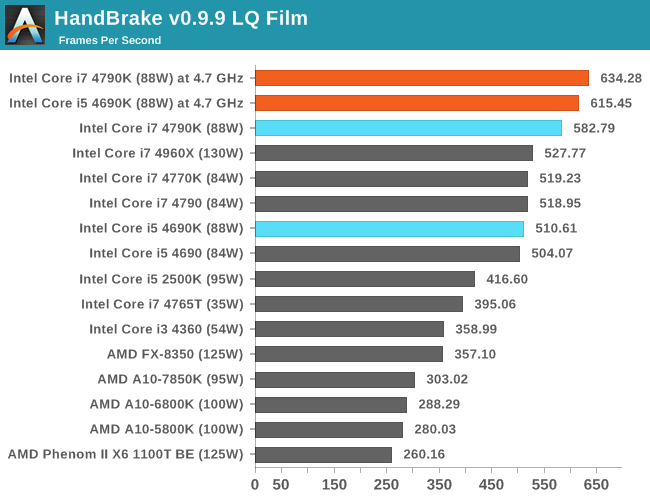
HandBrake, 4K60 Animation: link
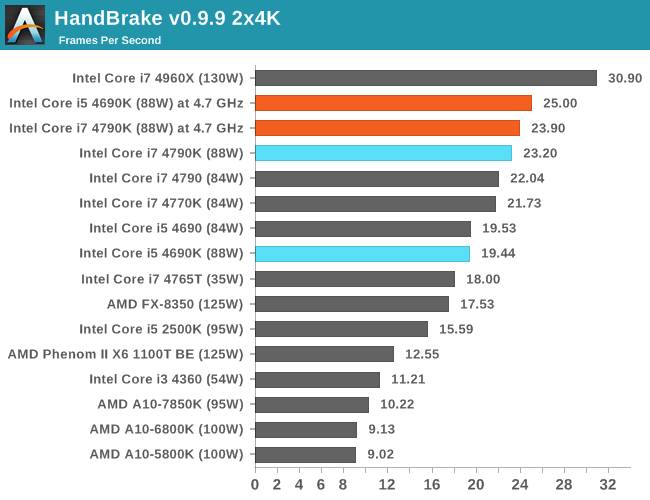
Agisoft Photoscan – 2D to 3D Image Manipulation: link
Agisoft Photoscan creates 3D models from 2D images, a process which is very computationally expensive. The algorithm is split into four distinct phases, and different phases of the model reconstruction require either fast memory, fast IPC, more cores, or even OpenCL compute devices to hand. Agisoft supplied us with a special version of the software to script the process, where we take 50 images of a stately home and convert it into a medium quality model. This benchmark typically takes around 15-20 minutes on a high end PC on the CPU alone, with GPUs reducing the time.
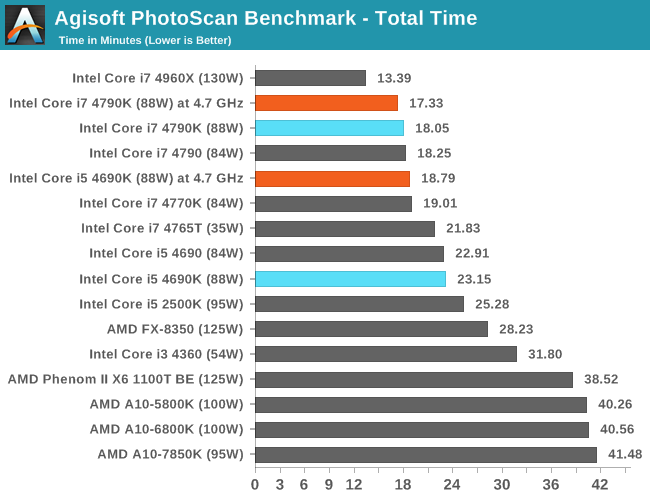
Dolphin Benchmark: link
Many emulators are often bound by single thread CPU performance, and general reports tended to suggest that Haswell provided a significant boost to emulator performance. This benchmark runs a Wii program that raytraces a complex 3D scene inside the Dolphin Wii emulator. Performance on this benchmark is a good proxy of the speed of Dolphin CPU emulation, which is an intensive single core task using most aspects of a CPU. Results are given in minutes, where the Wii itself scores 17.53 minutes.
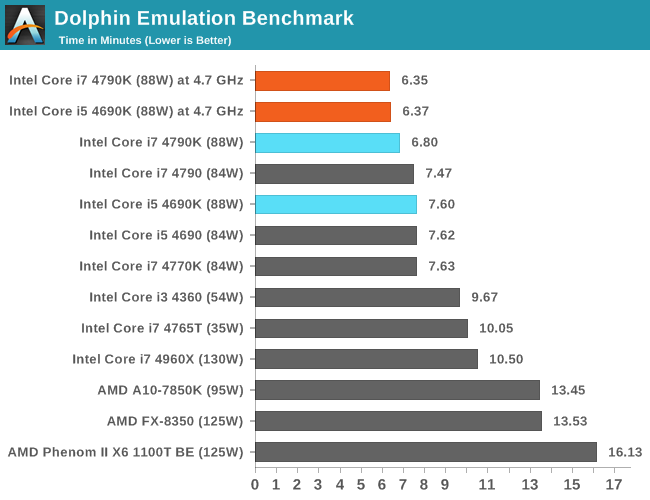
WinRAR 5.0.1: link
This test compresses a set of 2867 files across 320 folders totaling 1.52 GB in size – 95% of these files are small typical website files, and the rest (90% of the size) are small 30 second 720p videos.
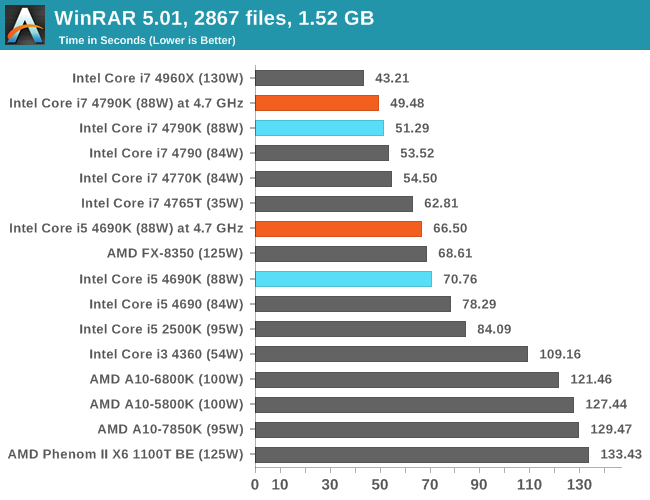
PCMark8 v2 Work 2.0 OpenCL on IGP
A new addition to our CPU testing suite is PCMark8 v2, where we test the Work 2.0 and Creative 3.0 suites in OpenCL mode. As this test is new, we have not run it on many AMD systems yet and will do so as soon as we can.
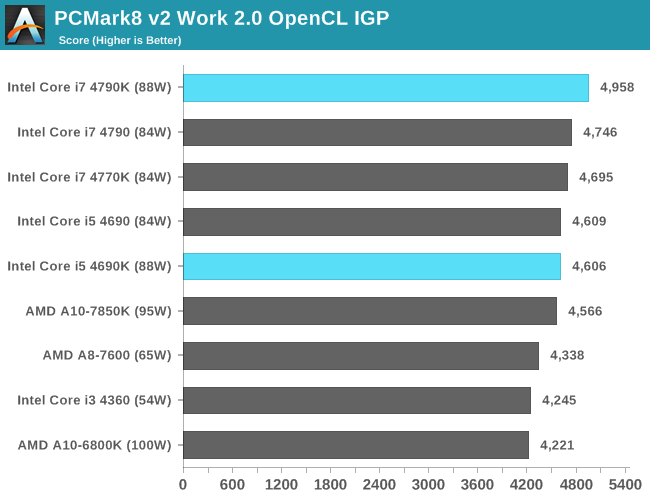
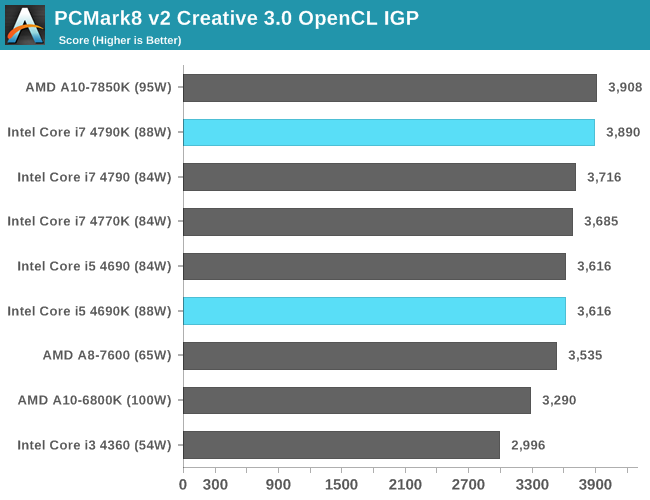
Hybrid x265
Hybrid is a new benchmark, where we take a 4K 1500 frame video and convert it into an x265 format without audio. Results are given in frames per second.
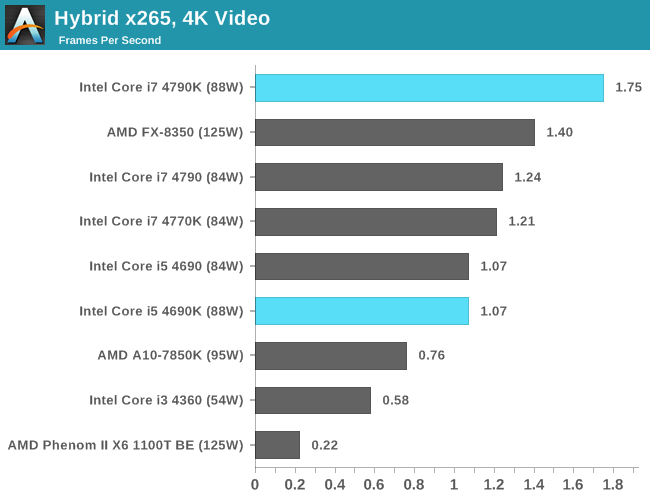
Cinebench R15
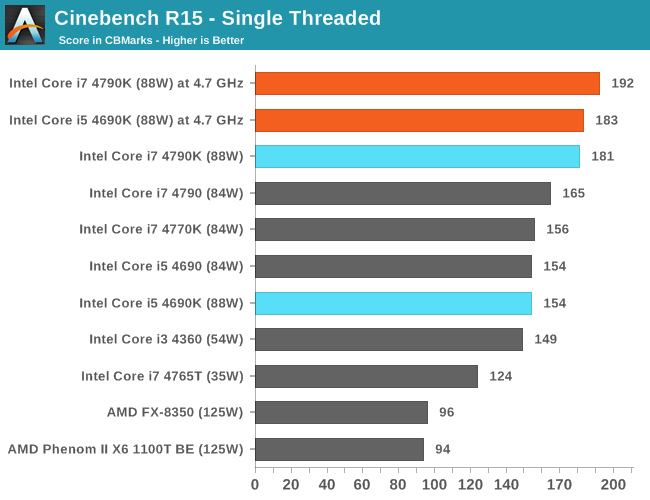

3D Particle Movement
3DPM is a self-penned benchmark, taking basic 3D movement algorithms used in Brownian Motion simulations and testing them for speed. High floating point performance, MHz and IPC wins in the single thread version, whereas the multithread version has to handle the threads and loves more cores.
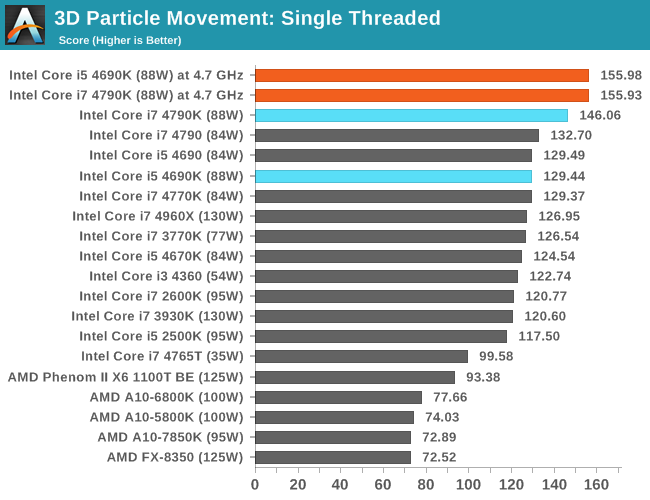
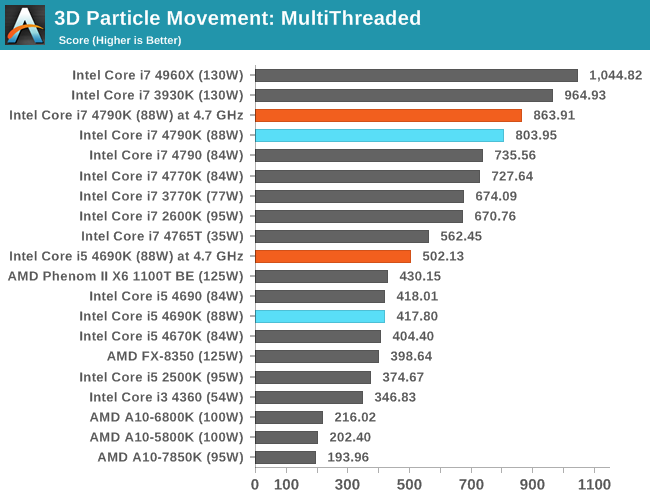
FastStone Image Viewer 4.9
FastStone is the program I use to perform quick or bulk actions on images, such as resizing, adjusting for color and cropping. In our test we take a series of 170 images in various sizes and formats and convert them all into 640x480 .gif files, maintaining the aspect ratio. FastStone does not use multithreading for this test, and results are given in seconds.
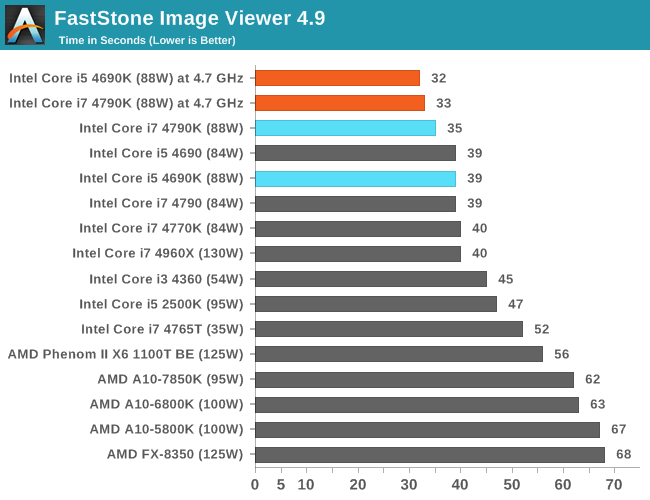
All of our CPU benchmarks are responsive to more frequency, and for tests that are all about single threaded performance (3DPM-ST, FastStone, Dolphin), the overclocked processors match each other. The highly clocked i7-4790K at stock is taking the lead in each of these benchmarks against the other processors at stock frequencies quite easily. For multi-threaded scenarios, it is interesting to note that when overclocked, Handbrake does not seem to use the extra threads that efficiently when encoding 4K60. This is presumably because each thread needs a fair amount of cache and there is little speed-up in switching the work between threads.










117 Comments
View All Comments
ZeDestructor - Friday, July 11, 2014 - link
Couldn't you use something with a dedicated server combined with kb/mouse emulation on a bunch of extra PCs running at 640x480 nonsense kind of thing?It's potentially more work, especially the potential synchronisation and timing issues, but it should be doable to within 10ms of latency (on my LAN I see ping roundtrips in the sub-ms range), should it not?
Ryan Smith - Friday, July 11, 2014 - link
In theory yes. But in practice most first-person games spawn you at a random point, which makes any kind of input track playback ineffective.The games where such a thing would work would tend to be games that already have better benchmark capabilities anyhow, such as racers and RTSes.
ZeDestructor - Friday, July 11, 2014 - link
Couldn't you get a modified DS from a dev?FlushedBubblyJock - Thursday, November 20, 2014 - link
They just don't want to do it.They live for their claimed accurate scientific method.
It will take a genius with guts or a brute with some money, then we can see the results we never get that we all want somewhere else.
Let's face it, it could be done and there would be some +/- low end percentage variability, so frames could be rounded to whole numbers removing the tenths ( which are outside the current bench errors and variability ).
It just isn't going to happen here, but someone should definitely do it, and we'd all love going there.
Real life scenarios are just too scary for the cold and removed and protected elite. Politics.
We all play our online games and know what frames we can count on given our vid cards and systems and current clocks and we all have our favorite maps and servers... etc.
Remember all these websites run the highest end overlcocked cpu and boards they possibly can, and that also is deceptive for most readers.
They run SSD's now with clean installs and used to go with defragged and rebooted but now methods are equivalent so nothing extra is running best case scenario stuff...
Yes another type of review site is needed, but then again the general idea is given for what info is available here, so downsize accordingly is the answer.
wallysb01 - Sunday, July 13, 2014 - link
If this is something that’s really needed for a real test, why not just do it 50 times per processor and do some stats.doggghouse - Friday, July 11, 2014 - link
Out of curiosity, what do people consider to be safe voltages for Haswell? I recently had to replace my 4770K with a 4790K because the chip started to BSOD even when not overclocked... I don't know if I helped speed its demise after having tested it at 1.4V several times, and I think I settled on 1.3V 4.4GHz daily use (it was a mediocre chip apparently).I apparently lucked out on my 4790K because it is running stable at 4.6GHz with only 1.25V, and 4.7GHz at 1.3125V. I was thinking about testing its upper limits for fun--try for the mythical 5GHz--but I don't want to accidentally burn out an otherwise great chip. I very briefly ran it at 5GHz with 1.424V and HT disabled, it was stable enough to run a few benchmarks. But if I play around in the 1.4V range, am I potentially going to wreck it?
TheinsanegamerN - Saturday, July 12, 2014 - link
Typically, for 22nm intel (sandy bridge and haswell) the typically regarded "safe 24/7 voltage" is only 1.3 volt on air, and 1.4 volt on water. for a very short period, higher than 1.4 can be used if you have VERY good cooling, but you may damage the vhip even with ln2 cooling at anything above 1.4v.Also, it sucks you had to do 1.3v to get to 4.4Ghz....I hit 4.2Ghz at only 1.075v. apparently got a REALLY good chip somehow, although i heard that the costa rica chips, of which mine is one, always did overclock better.
doggghouse - Monday, July 14, 2014 - link
Interesting... so is it the temps, and not the voltage directly, that eventually kills the chip? If so, would running lots of synthetic benchmarks that brings temps into the 90-100C range shorten its lifespan? I have an AIO water cooler, the Kraken X60, which can keep normal temps cool, but anything above 1.25V will still hit 100C on the latest Prime95 Small FFTs test.FlushedBubblyJock - Thursday, November 20, 2014 - link
Voltage can kill the cpu. You won't necessarily get the temp reading it can happen so fast.Secondarily, a higher voltage is more volatile with higher temps, so the combination can also cause electromigration blowouts.
Dustin Sklavos - Friday, July 11, 2014 - link
"A contact at Corsair.";)
Here are the complete results for my Devil's Canyon and Pentium chips:
4790K #1: 4.7GHz @ 1.275V
4790K #2: 4.7GHz @ 1.31V
4690K #1: 4.7GHz @ 1.375V
4690K #2: 4.8GHz @ 1.375V
G3258 #1: 4.9GHz @ 1.4V
G3258 #2: 4.7GHz @ 1.375V